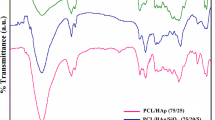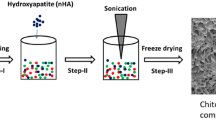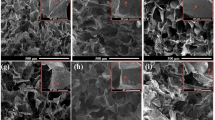Abstract
The aim of this work is to compare the effect of hydroxyapatite (HAp) or bioglass (BG) nanoparticles in a polycaprolactone composite scaffold aimed to bone regeneration. To allow a comparison of the influence of both types of fillers, scaffolds made of PCL or composites containing up to 20 % by weight HAp or BG were obtained. Scaffolds showed acceptable mechanical properties for its use and high interconnected porosity apt for cellular colonization. To study the effect of the different materials on pre-osteoblast cells differentiation, samples with 5 % mineral reinforcement, were cultured for up to 28 days in osteogenic medium. Cells proliferated in all scaffolds. Nevertheless, differentiation levels for the selected markers were higher in pure PCL scaffolds than in the composites; inclusion of bioactive particles showed no positive effects on cell differentiation. In osteogenic culture conditions, the presence of bioactive particles is thus not necessary in order to observe good differentiation.








Similar content being viewed by others
References
Palmer LC, Newcomb CJ, Kaltz SR, Spoerke ED, Stupp SI. Biomimetic systems for hydroxyapatite mineralization inspired by bone and enamel. Chem Rev. 2008;11:4754–83.
Stevens MM. Biomaterials for bone tissue engineering. Mater Today. 2008;11:18–25.
Shu R, McMullen R, Baumann MJ, McCabe LR. Hydroxyapatite accelerates differentiation and suppresses growth of MC3T3-E1 osteoblasts. J Biomed Mater Res Part A. 2003;67A:1196–204.
Wutticharoenmongkol P, Pavasant P, Supaphol P. Osteoblastic phenotype expression of MC3T3-E1 cultured on electrospun polycaprolactone fiber mats filled with hydroxyapatite nanoparticles. Biomacromolecules. 2007;8:2602–10.
Supova M. Problem of hydroxyapatite dispersion in polymer matrices: a review. J Mater Sci Mater Med. 2009;20:1201–13.
Braye F, Irigaray JL, Jallot E, Oudadesse H, Weber G, Deschamps N, Deschamps C, Frayssinet P, Tourermet P, Tixier H, Terve S, Lefaivrell J, Amirabad A. Resorption kinetics of osseous substitute: natural coral and svnthetic hydroxyapatite. Biomaterials. 1996;17:1345–50.
Valerio P, Pereira MM, Goes AM, Leite FM. The effect of ionic products from bioactive glass dissolution on osteoblast proliferation and collagen production. Biomaterials. 2004;25:2941–8.
Reffitt DM, Ogston N, Jugdaohsingh R, Cheung HFJ, Evans BAJ, Thompson RPH, Powell JJ, Hampson GN. Orthosilicic acid stimulates collagen type 1 synthesis and osteoblastic differentiation in human osteoblast-like cells in vitro. Bone. 2003;32:127–35.
Lakshmi SN, Cato TL. Biodegradable polymers as biomaterials. Prog Polym Sci. 2007;32:762–98.
Katsanevakis E, Wen X, Shi D, et al. Biomineralization of polymer scaffolds. Key Eng Mater. 2010;441:269–95.
Zhang K, Wang Y, Hillmyer MA, Francis LF. Processing and properties of porous poly(l-lactide)/bioactive glass composites. Biomaterials. 2004;25:2489–500.
Rezwan K, Chen QZ, Blaker JJ, Boccaccini AR. Biodegradable and bioactive porous polymer/inorganic composite scaffolds for bone tissue engineering. Biomaterials. 2006;27:3413–31.
Murphy WL, Kohn DH, Mooney DJ. Growth of continuous bonelike mineral within porous poly(lactide-co-glycolide) scaffolds in vitro. J Biomed Mater Res A. 2000;50:1549–3296.
Ma PX, Zhang R, Xiao G, Franceschi R. Engineering new bone tissue in vitro on highly porous poly(a-hydroxyl acids)/hydroxyapatite composite scaffolds. J Biomed Mater Res. 2000;54:284–93.
El-Ghannam A, Ducheyne P, Shapiro IM. Porous bioactive glass and hydroxyapatite ceramic affect bone cell function in vitro along different time lines. J Biomed Mater Res. 1998;36:167–80.
Matsuura T, Hosokawa R, Okamoto K, Kimoto T, Akagawa Y. Diverse mechanisms of osteoblast spreading on hydroxyapatite and titanium. Biomaterials. 2000;21:1121–7.
Woo KM, Seo J, Zhang R, Ma PX. Suppression of apoptosis by enhanced protein adsorption on polymer/hydroxyapatite composite scaffolds. Biomaterials. 2007;28:2622–30.
Kilpadi KL, Chang PL, Bellis SL. Hydroxylapatite binds more serum proteins, purified integrins, and osteoblast precursor cells than titanium or steel. J Biomed Mater Res. 2001;57:258–67.
Shor L, Güçeri S, Wen X, Gandhi M, Sun W. Fabrication of three-dimensional polycaprolactone/hydroxyapatite tissue scaffolds and osteoblast-scaffold interactions in vitro. Biomaterials. 2007;28:5291–7.
Chuenjitkuntaworn B, Inrung W, Damrongsri D, Mekaapiruk K, Supaphol P, Pavasant P. Polycaprolactone/hydroxyapatite composite scaffolds: preparation, characterization, and in vitro and in vivo biological responses of human primary bone cells. J Biomed Mater Res A. 2010;94:241–51.
Lua Y, Zhu A, Wang W, Shi H. New bioactive hybrid material of nano-hydroxyapatite based on N-carboxyethylchitosan for bone tissue engineering. Appl Surf Sci. 2010;256:7228–33.
Teng S, Chen L, Guo Y, Shi J. Formation of nano-hydroxyapatite in gelatin droplets and the resulting porous composite microspheres. J Inorg Biochem. 2007;101:686–91.
Li Z, Yubao L, Aiping Y, Xulein P, Xuejiang W, Xiang Z. Preparation and in vitro investigation of chitosan/nano-hydroxyapatite composite used as bone substitute materials. J Mater Sci Mater Med. 2005;16:213–9.
Puppi D, Chiellini F, Piras AM, Chiellini E. Polymeric materials for bone and cartilage repair. Prog Polym Sci. 2010;35:403–40.
Martin C, Winet H, Baot JY. Acidity near eroding polylactide–polyglycolide in vitro and in vivo in rabbit tibial bone chambers. Biomaterials. 1996;17:2373–80.
Diba M, Kharaziha M, Fathi MH, Gholipourmalekabadi M, Samadikuchaksaraei A. Preparation and characterization of polycaprolactone/forsterite nanocomposite porous scaffolds designed for bone tissue regeneration. Compos Sci Technol. 2012;72:716–23.
Rizzi SC, Heath DJ, Coombes AGA, Bock N, Textor M, Downes S. Biodegradable polymer/hydroxyapatite composites: surface analysis and initial attachment of human osteoblasts. J Biomed Mater Res. 2001;55:475–86.
Fabbri P, Cannillo V, Sola A, Dorigato A, Chiellini F. Highly porous polycaprolactone-45S5 Bioglass® scaffolds for bone tissue engineering. Compos Sci Technol. 2011;70:1869–78.
Cannillo V, Chiellini F, Fabbri P, Sola A. Production of Bioglass® 45S5–polycaprolactone composite scaffolds via salt-leaching. Compos struct. 2010;92:1823–32.
Deb S, Mandegaran R, Di Silvio L. A porous scaffold for bone tissue engineering/45S5 Bioglass® derived porous scaffolds for co-culturing osteoblasts and endothelial cells. J Mater Sci Mater Med. 2010;21:893–905.
Lebourg M, Suay Antón J, Gomez Ribelles JL. Hybrid structure in PCL-HAp scaffold resulting from biomimetic apatite growth. J Mater Sci Mater Med. 2010;21:33–44.
Ho M-H, Kuo P-Y, Hsieh H-J, Hsien T-Y, Hou L-T, Lai J-Y, Wang D-M. Preparation of porous scaffolds by using freeze-extraction and freeze-gelation methods. Biomaterials. 2004;25:129–38.
Storrie H, Stupp SI. Cellular response to zinc-containing organoapatite: an in vitro study of proliferation, alkaline phosphatase activity and biomineralization. Biomaterials. 2005;26:5492–9.
Meloan SN, Puchtler H. Chemical mechanisms of staining methods: von Kossa’s technique. What von Kossa really wrote and a modified reaction for selective demonstration of inorganic phosphate. J Histotechnol. 1985;8:11–3.
Habibovic P, Sees TM, van den Doel MA, van Blitterswijk CA, de Groot K. Osteoinduction by biomaterials-physicochemical and structural influences. J Biomed Mater Res A. 2006;77A:747–62.
Bohner M, Lemaitre J. Can bioactivity be tested in vitro with SBF solution? Biomaterials. 2009;30:2175–9.
Li X, van Blitterswijk CA, Feng Q, Cui F, Watari F. The effect of calcium phosphate microstructure on bone-related cells in vitro. Biomaterials. 2008;29:3306–16.
Denis FA, Hanarp P, Sutherland DS, Gold J, Mustin C, Rouxhet PG, Dufrêne YF. Protein adsorption on model surfaces with controlled nanotopography and chemistry. Langmuir. 2002;18:819–28.
Galli C, Coen MC, Hauert R, Katanaev VL, Gröning P, Schlapbach L. Creation of nanostructures to study the topographical dependency of protein adsorption. Colloids Surf B Biointerfaces. 2002;26:255–67.
Cai L, Guinn AS, Wang S. Exposed hydroxyapatite particles on the surface of photo-crosslinked nanocomposites for promoting MC3T3 cell proliferation and differentiation. Acta Biomater. 2011;7:2185–99.
Pitt CG, Zhong-wei G. Modification of the rates of chain cleavage of poly(ϵ-caprolactone) and related polyesters in the solid state. J Control Release. 1987;4(4):283–92.
Kaysinger KK, Ramp WK. Extracellular pH modulates the activity of cultured human osteoblasts. J Cell Biochem. 1998;68:83–9.
Wei G, Ma PX. Structure and properties of nano-hydroxyapatite/polymer composite scaffolds for bone tissue engineering. Biomaterials. 2004;25:4749–57.
Lee HJ, Kim SE, Choi HW, Kim CW, Kim KJ, Lee SC. The effect of surface-modified nano-hydroxyapatite on biocompatibility of poly(ε-caprolactone)/hydroxyapatite nanocomposites. Eur Polym J. 2007;43:1602–8.
Verrier S, Blaker JJ, Maquet V, Hencha LL, Boccaccini AR. PDLLA/bioglass composites for soft-tissue and hard tissue engineering: an in vitro cell biology assessment. Biomaterials. 2004;25:3013–21.
Lian JB, Stein GS. Concepts of osteoblast growth osteoblast growth and differentiation: modulation of bone cell development and tissue formation. Critical Rev Oral Biol Med. 1992;3(3):269–305.
Choi JY, lee BH, Song KB, Park RW, Kim IS, Sohn KY, Jo JS, Ryoo HM. Expression patterns of bone-related proteins during osteoblastic differentiation in MC3T3-E1 cells. J Cell Biochem. 1996;61:609–18.
Al-Jallad HF, Nakano Y, Chen JLY, McMillan E, Lefebvre C, Kaartinen MT. Transglutaminase activity regulates osteoblast differentiation and matrix mineralization in MC3T3-E1 osteoblast cultures. Matrix Biol. 2006;25:135–48.
Varanasi VG, Saiz E, Loomer PM, Ancheta B, Uritani N, Ho SP, Tomsia AP, Marshall SJ, Marshall GW. Enhanced osteocalcin expression by osteoblast-like cells (MC3T3-E1) exposed to bioactive coating glass (SiO2–CaO–P2O5–MgO–K2O–Na2O system) ions. Acta Biomater. 2009;5:3536–47.
Foppiano S, Marshall SJ, Marshall GW, Saiz E, Tomsia AP. Bioactive glass coatings affect the behavior of osteoblast-like cells. Acta Biomater. 2007;3:765–71.
Reilly GC, Radin S, Chen AT, Ducheyne P. Differential alkaline phosphatase responses of rat and human bone marrow derived mesenchymal stem cells to 45S5 bioactive glass. Biomaterials. 2007;28:4091–7.
Li LH, Kommareddy KP, Pilz C, Zhou CR, Fratzl P, Manjubala I. In vitro bioactivity of bioresorbable porous polymeric scaffolds incorporating hydroxyapatite microspheres. Acta Biomater. 2010;6:2525–31.
Schneider GB, Perinpanayagam H, Clegg M, Zaharias R, Seabold D, Keller J, Stanford C. Implant surface roughness affects osteoblast gene expression. J Dent Res. 2003;82:372–6.
Alliot-Licht B, Gregoire M, Orly I, Menanteau J. Cellular activity of osteoblasts in the presence of hydroxyapatite: an in vitro experiment. Biomaterials. 1991;12:752–6.
Prigodich RV, Vesely MR. Characterization of the complex between bovine osteocalcin and type I collagen. Arch Biochem Biophys. 1997;345(2):339–41.
Wenstrup RJ, Fowlkes JL, Wittei DP, Florer JB. Discordant expression of osteoblast markers in MC3T3-E1 cells that synthesize a high turnover matrix. J Biol Chem. 1996;271(17):10271–6.
Franceschi RT, Iyer BS, Cui Y. Effects of ascorbic acid on collagen matrix formation and osteoblast differentiation in murine MC3T3-E1 cells. J Bone Miner Res. 1994;9:843–54.
Bonewald LF. Cell–cell and cell–matrix interactions in bone. In: Bradshaw RA, Dennis EA, editors. Handbook of Cell Signaling (Second Edition). Elsevier Academic Press; 2009. pp 109-124.
Xu L, Anderson AL, Lu Q, Wang J. Role of fibrillar structure of collagenous carrier in bone sialoprotein-mediated matrix mineralization and osteoblast differentiation. Biomaterials. 2007;28:750–61.
Acknowledgments
JLGR acknowledges the support of the Spanish Ministry of Science and Education through project No. MAT2010-21611-C03-01 (including the FEDER financial support), and from Generalitat Valenciana, ACOMP/2012/075 Project.. Lebourg acknowledges the support of UPV through Project PAID-O6-10 and thanks CIBER-BBN for funding her post-doc research. CIBER-BBN is an initiative funded by the VI National R&D&i Plan 2008–2011, Iniciativa Ingenio 2010, Consolider Program, CIBER Actions and financed by the Instituto de Salud Carlos III with assistance from the European Regional Development Fund. J. Ródenas acknowledges the funding of his PhD by the Generalitat Valenciana through VALi+d Grant. The authors also wish to thank the microscopy service of Universidad Politécnica de Valencia as well as the confocal microscopy service of the Research Centre Principe Felipe for useful help and advice.
Author information
Authors and Affiliations
Corresponding author
Electronic supplementary material
Below is the link to the electronic supplementary material.
Rights and permissions
About this article
Cite this article
Ródenas-Rochina, J., Ribelles, J.L.G. & Lebourg, M. Comparative study of PCL-HAp and PCL-bioglass composite scaffolds for bone tissue engineering. J Mater Sci: Mater Med 24, 1293–1308 (2013). https://doi.org/10.1007/s10856-013-4878-5
Received:
Accepted:
Published:
Issue Date:
DOI: https://doi.org/10.1007/s10856-013-4878-5




